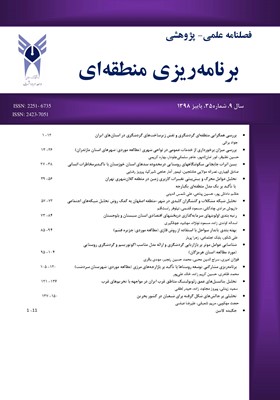تحلیل و ارزیابی نابرابریهای کیفیت زندگی در محلات شهری (نمونه موردی: شهر فارسان)
محورهای موضوعی : فصلنامه علمی برنامه ریزی منطقه ای
علی حاجی نژاد
1
*
,
جعفر قادری
2
![]() ,
عزت الله قاسمی قاسموند
3
,
عزت الله قاسمی قاسموند
3
1 - دانشیار گروه جغرافیا و برنامه ریزی روستایی، دانشگاه گیلان، رشت، ایران
2 - استادیار گروه اقتصاد شهری، دانشگاه شیراز، شیراز، ایران
3 - کارشناس ارشد جغرافیا و برنامهریزی شهری، دانشگاه سیستان و بلوچستان، زاهدان، ایران
کلید واژه: نابرابری, محلات شهری, کیفیت زندگی شهری, شهر فارسان,
چکیده مقاله :
پژوهشهای صورت گرفته در ارتباط با کیفیت زندگی و پایداری شهری بهخوبی نشان میدهد که رابطهی تنگاتنگی میان ناپایداری شهری و کیفیت زندگی در شهرها وجود دارد. به همین دلیل است که امروزه پرداختن به این موضوع در فرآیند برنامهریزی شهری از کلیدیترین ابعاد این حوزه به شمار میرود. معیارهایی همچون میزان توسعهیافتگی شهری و نحوهی توزیع فضایی آن، سطح برخورداری یا نابرابری در بهرهمندی از خدمات و کارکردهای مختلف در مقیاس محلات و نواحی شهری، از عوامل مؤثر بر کیفیت زندگی شهری به شمار میرود. هدف از پژوهش حاضر ارزیابی و سطحبندی برابری و یا نابرابری کیفیت زندگیِ شهری در سطح محلات و نواحی چهارگانه شهر فارسان است. روش تحقیق؛ توصیفی تحلیلی و جمعآوری اطلاعات از طریق مطالعات میدانی و با استفاده از ابزار پرسشنامه و با حجم نمونه 320 نفر از شهروندان در چهار ناحیه شهر فارسان انجامگرفته است. جهت تحلیل اطلاعات از مدل تصمیمگیری تاپسیس استفاده شده است. یافتههای پژوهش گویای آن است که محلات ناحیه دو شهر فارسان در شاخصهای اقتصادی، با امتیاز841/0، اجتماعی با امتیاز 981/0 و کالبدی با امتیاز 930/0 در رتبه اول و محلات ناحیه یک این شهر رتبه آخر را به خود اختصاص دادهاند. همچنین از منظر شاخص زیستمحیطی، محلات ناحیه چهار با امتیاز 986/0 در رتبه نخست و ناحیه سه با امتیاز266/0 در رتبه آخر قرار گرفتهاند.
The concept of quality of life can be a powerful tool used to monitor the planning and development of society. Since this concept, encompasses all aspects such as economic, social, environmental and physical, can be programmed to monitor the community, assess the effectiveness and efficiency of current policies and programs and develop new programs to help. Research carried out in relation to quality of life and urban sustainability clearly shows the close relationship between the quality of urban life and urban instability. That is why today addressing this issue in the process of urban planning of these areas is the key. Criteria such as the level of urban development and how its spatial distribution, Level and how to enjoyment or inequality in the enjoyment or benefit from the services, and functions in scale neighborhoods and urban areas are factors affecting the quality of urban life in general. Assessing and Leveling equality or inequality of urban quality life in the four areas and neighborhoods of Farsan City was the aim of this study. The research method is descriptive. A study conducted a field survey and data collected by using a questionnaire. A sample was 320 people who have been chosen from among residents of four Farsan Area. TOPSIS decision model used to analyze the data. The findings suggest that the district No.2 of Farsan' neighborhoods with a score of 0.841 in economic indicators, a score of 0.981 in social indicators ,and a score of 0.930 in skeletal indicators has the first place and the district No.1 of Farsan' neighborhoods has the last place in the city neighborhoods. Also from the perspective of environmental factors, district No.4 with a score of 0.986 has the first place and district No.3 with a score of 0.266 is at the end of list.
_||_

